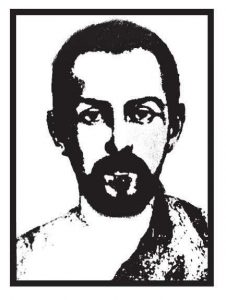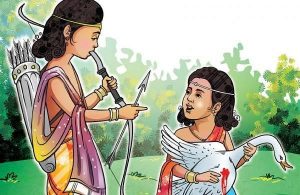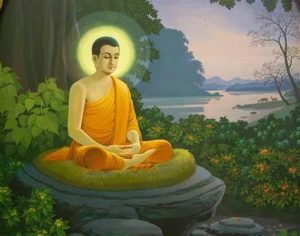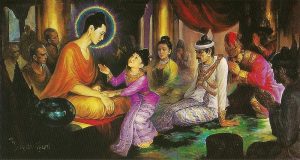Top Five Things that I Learn from the Buddha’s Early Life

The Buddha, the Enlightened One
This image, which is based upon ancient Indian oral and visual tradition, is thought best to represent the Buddha as he actually appeared.
Source: John Stevens,
Lust for Enlightenment: Buddhism and Sex
(Boston, MA, and London: Shambhala Publications [1990], p. 14)
(Credit: https://bit.ly/43UNp6i)
Contents
- Introduction
- Brief overview of the life of the Buddha
- Top five things that I learn from the Buddha’s early life
- Fondness for learning
- Practicing meditation
- Being kind and compassionate to beings
- Being a success-driven individual
- Having unwavering love for family – revisiting them at 36 years of age
- Conclusion
Introduction
“In the Buddha (c. 563–483 BCE) we have a master mind…, second to none so far as the influence on the thought and life of the human race is concerned, and sacred to all as the founder of a religious tradition whose hold is hardly less wide and deep than any other. He belongs to the history of the world’s thought, to the general inheritance of all cultivated men; for, judged by intellectual integrity, moral earnestness, and spiritual insight, he is undoubtedly one of the greatest figures in history.”[1]
Thus declared Dr. S. Radhakrishnan, an Indian philosopher and statesman who was the 2nd president of India from 1962 to 1967.
Today, the Buddha – who founded Buddhism, the world’s fifth largest religion – is still highly revered across the globe. Every year, an international day is designated to honor Him – the Buddha’s Day. The Buddha’s Day is also known as “Vesak”, “Wisak”, “Buddha Purnima”, and in Thailand “Visakha Bucha Day”. It is the day that 506 million Buddhists around the world commemorate the birth, enlightenment, and passing-away of the Buddha.
Three places connected with the birth, enlightenment and passing-away of the Buddha
Vesak usually falls on the full moon day in May – or June if it is a year with an extra eighth lunar month. For this year, the observance can be held on two separate days – either on 4th May for the Buddhist community that does not observe an extra lunar month, or 3rd June for the Buddhists counting on an extra eighth lunar month in their calendar. For example, Buddhists in Bangladesh, Cambodia, Myanmar, Nepal and Laos observe the holy day in early May 2023, while Buddhists in Indonesia, Mongolia, Singapore and Thailand will commemorate it in early June 2023; and Buddhists in India may do it on both occasions.
In Thailand, the Visakha Bucha Day will be celebrated on 3rd June 2023.
Brief Overview of the Life of the Buddha from Birth to Passing-away (Parinibbana or Parinirvana)
The Buddha was born Siddhattha Gotama or Siddhartha Gautama into a wealthy ruling family in Shakya republic whose capital was Kapilavatthu or Kapilavastu (modern-day Taulihawa or Tilaurakot in Nepal), bordering India.
As a young man, Prince Siddhattha led a sheltered and privileged life. He was known for his strong dedication to learning in both mundane and spiritual matters, including meditation (samadhi). At the age of 29, he left his palace and began a journey in search of the Path to spiritual freedom. He practiced voluntary self-mortification, such as fasting, for six years. Finding that self-mortification could not give him the answers he sought, he turned to focus on meditation and one day, in the city of Uruvela (modern-day Bodh Gaya), he meditated until he attained Enlightenment. Afterwards, he became known as “The Buddha”, “The Enlightened One” or “The Awakened One”, at the age of 35.
After achieving Enlightenment, the Buddha endeavored to enlighten others and liberate them from the ills of life. He was one of the most energetic and the most active religious teachers that ever lived. According to the Buddha’s daily routine in “The Life of the Buddha”, he normally got up very early in the morning, meditated, radiated thoughts of loving-kindness and compassion towards all beings, and surveyed the world with his Mental Eye or Divine Eye to see if there were people who needed his spiritual assistance. If he saw any, he would go to help them. His day was fully occupied with religious activities until bedtime about 2 a.m.
During the day the Buddha preached or talked to people from all walks of life. He encouraged monks and nuns to practice his teachings for their own enlightenment and for that of other fellow humans; advised lay people to live a morally upright life; counseled kings and royalty to rule justly and fairly as well as encouraged them to practice the Dhamma to set an example for people to follow; engaged in dialogue with brahmins, scholars, wanderers and ascetics on beliefs and practices, and offered his own teachings as an alternative; assured skeptics and agnostics that it is possible to attain spiritual liberation through one’s own efforts, without relying on divine intervention; and welcomed outcasts and untouchables into the Buddhist community and taught them that all human beings are equal in their potential for enlightenment.
According to The Pali Canon, What a Buddhist Must Know, p. 6, teachings of the Buddha consist of as many as 84,000 textual units. These teachings, the products of his pure insightfulness, included informal conversations, debates, and discussions with his disciples and others on main tenets such as moral responsibility, the Four Noble Truths, the Noble Eightfold Path, Kamma or Karma, rebirth, Dependent Origination, meditation, and Nibbana or Nirvana. The Buddha’s teachings were usually tailored to the needs and capacities of his listeners, so he may have taught the same or similar concepts in different ways to different audiences.
The Buddha tirelessly worked for the good and happiness of all beings until his passing-away at the age of 80 at Kusinara (modern-day Kushinagar).

Map of the areas in Nepal, the states of Bihar and Uttar Pradesh in India where the Buddha probably spent his whole life (photo credit: Footprints in the Dust: The Life of the Buddha from the Most Ancient Sources, p. 114)
Top Five Things That I Learn from the Buddha’s Early Life
In spite of the fact that the Buddha taught more than 84,000 Dharma topics and set countless examples for us to follow in order to attain true peace and freedom from suffering, I would like to mention only the five things that I learned from his early life: fondness of learning; practicing meditation; having empathy and compassion for others; being a success-driven man; and having endless love for his family.
- Fondness for Learning
Prince Siddhattha had a thirst for knowledge and as a son of the ruling family who was destined to be the next ruler, his father had him start education at an early age. He must have learnt many civil and military subjects[2], including the art of handling elephants, horses, chariots, and the use of arms, and so forth.
According the Buddha and His Dharma, p. 32, two of Prince Siddhattha’s prominent teachers were Sabbamitta and Bhardawaj. Sabbamitta was a renowned philologist, grammarian, and well read in the Vedas, the earliest literary record of Indo-Aryan civilization and the most sacred books of India; Vedangas, the six auxiliary disciplines of Hinduism that developed in ancient times and have been connected with the study of the Vedas. The six Vedangas are Siksha (phonetics), Chhanda (poetics), Vyakarana (grammar), Nirukta (etymology), Jyotisha (astronomy) and Kalpa (ritual); and Upanishads, ancient scriptures that are considered to be some of the foundational texts of Hinduism. Part of the Vedas, the Upanishads are written in Sanskrit and are thought to date back to the 8th century BCE or earlier. They mainly center on karma, Brahman, atman, and moksha. Under him, Prince Siddhattha mastered all the philosophic systems prevalent in his day.

Hindu scriptures that Prince Siddhattha must have studied.
The other teacher Bhardawaj taught Siddhattha the science of concentration and meditation, which later became an essential factor for his enlightenment. The Buddha even habitually used mindfulness meditation for resting his body and mind throughout his life (see Buddhadhamma: The Law of Natures and Their Benefits to Life, p. 1782).
- Practicing Meditation
The Life and Teachings of the Buddha, according to the oldest texts, p. 20 mentioned that when Prince Siddhattha was seven years old, his father King Suddhodana took him to a plowing festival. During the festivities, the young prince was taken by his attendants to rest under the cool shade of a rose-apple tree. While seated on a specially-prepared couch, he started to contemplate his inhales and exhales, which resulted in the attainment of the first Jhana (absorption). Later, meditation became the instrument for his Enlightenment. It was also the means for his body and mental relaxation throughout his life.

Prince Siddhattha meditates under a tree (Photo credit: https://bit.ly/3VVV7cR)
Prince Siddhattha was a meditation prodigy. To understand how a very young Siddhattha could engage himself in meditation, we may look at some modern-day prodigies. Blaise Pascal (1623–1662), a French mathematician, physicist, and religious philosopher, wrote a treatise on vibrating bodies at the age of nine. Wolfgang Amadeus Mozart (1756 – 1791), who composed more than 800 works, wrote the first piece at the age of five. Leonel Messi, one of the greatest football players of all time, joined a local football club at the age of four. And Novak Djokovic, one of the greatest tennis players of all time, also began playing tennis at the age of four.
In addition to being the tool for the Buddha-to-be to attain Enlightenment, meditation – both mindfulness meditation and loving-kindness meditation – has been found by psychological and brain scientists to be very beneficial for lay people in day-to-day life. Emotional management and physical health will be enhanced by regularly practicing meditation.
Meditation is also very popular among famous people. For example, Bill Gates has written, “Why I’m into meditation” and he says his new favorite habit helps him focus—and it only takes 30 minutes per week, Yuval Noah Harari has revealed that Vipassana Meditation helps him write his books, and Novak Djokovic is an avid meditator.
One may start meditating for three minutes a day at the same time every day to build a habit, as advised by CNN. Once you are feeling comfortable, you can increase the duration to at least ten minutes a day in one session. The longer the meditation period is, the better for the practitioners – for good health and self-awareness.
For more information on meditation especially in Thailand, see the article Meditation in Thailand.
- Being Kind and Compassionate to Beings
The Buddha is known for his kindness and compassion towards all living beings. He taught in SN.15.14-19 that almost all beings are interconnected saying, “Monks, this Samsara (round of births and rebirths) is without a discoverable beginning… It is not easy to find a being who in this long course has not previously been your mother…your father…your sister…your brother…your daughter…your son….” This Buddha’s insight into the interconnectedness of living beings should be a guiding light for human beings to cultivate understanding and compassion towards others, who may be our parents, sons or daughters, brothers or sisters in previous lives, and treat them accordingly at an appropriate time.
At the age of nine, Prince Siddhattha saved the life of a swan that had been shot by one of his cousin’s arrows. The wounded bird fell onto the ground where the prince was playing, he carefully removed the arrow, nursed the swan back to health, and released it. This story highlights the Buddha’s emphasis on nonviolence and the importance of showing empathy and care towards others, even the small creatures.

Prince Siddhattha saves a wounded swan (Photo credit: https://binged.it/41ou7DX)
- Being a Success-Driven Individual
Prince Siddhattha was a success-focused man. After leaving his palace at the age of 29, he went to further study meditation with at least two prominent teachers – Alara Kalama at Vesali or Vaishali and Uddaka Ramaputta in Rajagaha (modern-day Rajgir, in Bihar state).
Although in the beginning he practiced extreme forms of asceticism, eventually he realized that self-mortification could not lead to enlightenment, and in the sixth year he abandoned it. Instead, he began to focus on meditation practice. One day, on a night of the sixth lunar month – usually falling in May-June – sitting on a Kusha grass mat under a Pipal tree – later known as Bodhi tree by virtue of it being the tree under which the Buddha-to-be attained enlightenment – he sat and took a firm resolution, “Upon this seat, though my body dry up and my skin, my bones and my flesh be dissolved – without having reached Enlightenment, no matter how long and difficult to reach, I shall not stir from this seat.”

The Buddha during the enlightenment sitting (credit: https://binged.it/42LtB3X)
But he did not have to go to such lengths, for his complete success came only twenty-four hours later. The following day – before dawn – he attained Enlightenment, thus becoming the Buddha.
On the topic of his Enlightenment, the Buddha was quoted in The Life of the Buddha, according to the Ancient Texts and Monuments of India, p. 123 as saying, “Here is suffering and here is the origin of suffering, here is the suppression of suffering; here is the way which leads to the suppression of suffering. All this I have come to know as it is.” and in The Life of the Buddha, As Legend and History, p. 68 as saying, “I realized that destruction is rebirth, the religious life has been led, done is what to be done, there is nought (for me) beyond this world.”
- Having Unwavering Love for His Family
The Buddha was a good son, husband, and father. He had everlasting love for his parents and family, and acted accordingly. He left them in search of the Path at the age of 29, he returned home seven years later after having found it. His departure from and reunion with his family was portrayed in Old Path White Clouds, chapters 12: Kanthaka, and 34: Reunion that before he left, he had assured his wife Yasodhara, “Please don’t worry. You are a woman of depth. You are my partner, the one who can help me to truly fulfill my quest. You understand me more than anyone else. If in the future I must leave and travel far from you, I know you possess the courage to continue your work. You will care for and raise our child well. Though I am gone, though I am far away from you, my love for you remains the same. I will never stop loving you, Gopa. With that knowledge, you will be able to endure our separation. And when I have found the Way, I will return to you and to our child.”
He repeated the same message to his parents,
“I will never abandon you. I am only asking you to let me go away for a time. When I have found the Way, I will return.”
As promised with his parents and wife, in the following year, after Enlightenment he returned home to Kapilavatthu or Kapilavastu (modern Taulihawa or Tilaurakot in Nepal) to visit them. He had to walk, with 300 disciples, a distance of about 240 kilometers (149 miles) from Rajagaha (modern-day Rajgir in Magadh, Bihar State, India).
During the joyful moment of reunion, the Buddha spoke to his father, mother, wife,
“Father, I have returned. Mother, I have returned. See, Gopa (his wife’s nickname he preferred to address), I came back to you.”

The Buddha and his son Rahul during his first homecoming in the following year after Enlightenment (Photo credit: https://binged.it/44OSzBq)
As a spiritual leader, the Buddha took a very good care of his parents and family. He taught his father the Way and thus, his father died as a lay Arahant or enlightened being. This happened when the Buddha was about forty years old (see pp. 75-91 here). After the king’s death, his mother and wife became nuns. But much earlier, his own son had already become a novice monk. They all attained Arahantship, the highest sainthood in Buddhism.
Conclusion
These are the top five things that I learn from the early life of the Buddha. They can be examples for all of us to follow. We should celebrate Buddha’s Day by following his examples and practicing his teachings, which will concurrently be beneficial to the practitioners themselves as well as other living beings in the society. In the Buddha’s view, paying homage by practice is the highest kind of homage.
Author: Paitoon Songkaeo, Ph.D.
May 2023
Bibliography
Ambedkar, B.R. The Buddha and His Dhamma. People’s Education Society. Siddharth Publication, Third Edition 1984.
Foucher, A. The Life of the Buddha: According to the Ancient Texts and Monuments of India. Translated into English by Simone Brangier Boas. Munshiram Manoharlal Publishers Pvt. Ltd. First Indian Edition 2003.
Malalasekera, G.P. Dictionary of Pali Proper Names, Vol. 1 A-DH. Motilal Banarsidas Publishers Pvt. Ltd., Delhi. 1960. (Entry: Kapilavatthu, pp. 516-520)
Payutto, Bhikkhu P.A. Buddhadhamma: The Law of Natures and Their Benefits to Life. 2015.
Payutto, Bhikkhu P.A. The Pali Canon: What a Buddhist Must Know. 2015.
Thich Nhat Hanh. Old Path White Clouds, Walking in the Footsteps of the Buddha, (Chapter Twelve: Kanthaka) pp. 79-86. Hin Pocket Book. 2017.
Endnotes
[1] K. Sri Dhammananda. (1965), ‘Great Personalities on Buddhism’, page 5. B.M.S. Publication.
[2] The Life of the Buddha: According to the Ancient Texts and Monuments of India, pp. 53-58


